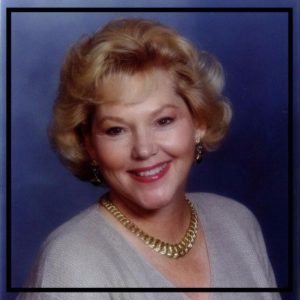
Frances Bourque is a legend…and we love her.
One of Delray’s heroes received much deserved recognition recently and I can’t let the opportunity to write about Frances Bourque pass me by.
Frances—the founder of Old School Square and the inspiration behind so much good in Delray Beach—was awarded the Distinguished Achievement Award by the University of Florida. It’s a rare honor and truly a “big deal” as they say.
The award recognizes exceptional achievement and leadership that merits the special recognition of the University. While a committee on honorary degrees vets the nominees, winners have to be personally approved by the University of Florida’s President. Dr. Kent Fuchs knows talent when he sees it and I’m sure when the president reviewed Frances’ materials it was an easy decision to bestow the honor.
The effort to recognize the force behind Delray’s signature civic achievement was launched by Frances’ sister Judy who reached out to several of Frances’ friends, colleagues and admirers (which is just about everyone) to help write the application. I was honored to be included in the effort and it was truly a pleasure to write about Frances’ influence on the city we love.
Old School Square is the rare project that addresses our past, present and future. Its genius lies in the fact that it touches so many aspects of community building: historic preservation, adaptive reuse of buildings, art, culture, education and so much more. But perhaps its greatest value is that Old School Square gives us a place to gather as a community.
And you can’t put a price on that simple gift.
Old School Square is where we headed after 9/11. It was where we met to discuss the Jerrod Miller shooting in 2005 and where we gather for Town Hall meetings, special performances, speeches, art exhibits and scores of festivals.
It sits at main and main on Atlantic and Swinton—if you had to design a better location you couldn’t.
And yet….
And yet before Frances nobody saw the potential. They saw a rusted chain link fence, crumbling buildings and blight. But Frances saw potential and beauty. Some saw the need for new office buildings. Others saw the need for a downtown anchor store. Frances saw a place to gather and celebrate the arts—the best of humanity.
Pretty soon, everyone shared the vision. That’s Frances’ magic. She makes you see, she makes you believe and while you may have to work hard to get there you don’t mind the journey because she makes every step of the way fun.
Earlier this week, I wrote about the 100th anniversary of Plastridge Insurance and the leadership contributions of Tom Lynch and his family. Frances is yet another example of how a community can be blessed when an extraordinary individual decides to fall in love with a place and commit to a vision.
Back in November, when Frances received word of the award she wrote a few of us an email. She had just driven 12 hours from Highlands, N.C. and was tired. When she got home and saw the letter from President Fuchs she immediately reached out—and immediately sought to share credit. She was clearly elated, but she quoted Thomas Merton who said “no man is an island” and said the recognition belonged to “ALL (her caps) of us!”
Typical Frances.
The truly great ones are humble. They seek to share credit.
People like Frances don’t do what they do for the awards. But it is important to recognize them and to celebrate their achievements so that we too may learn, appreciate and be inspired to get to work ourselves.
For 32 years, I have hung on her every word. She remains an inspiration to all who are blessed to have crossed her path.

